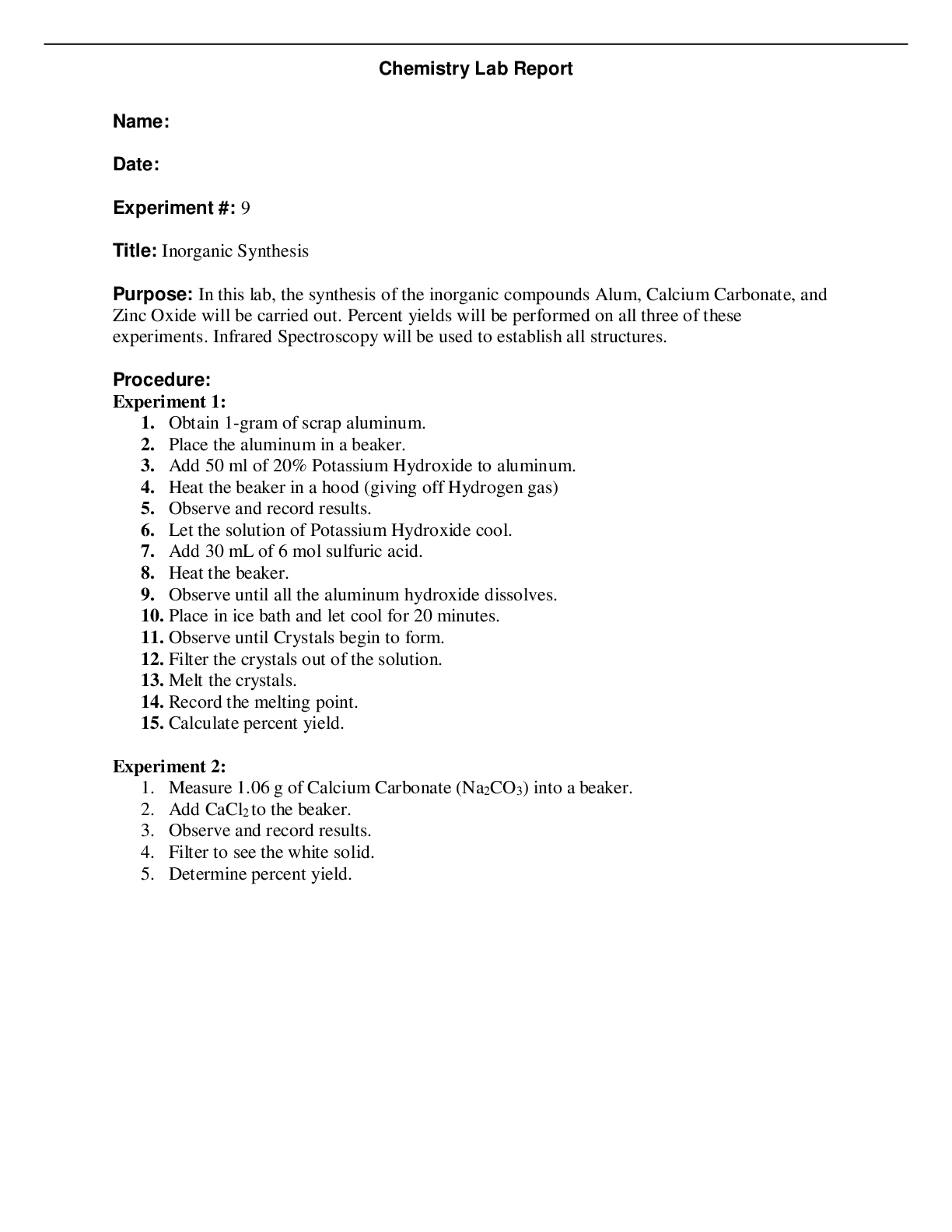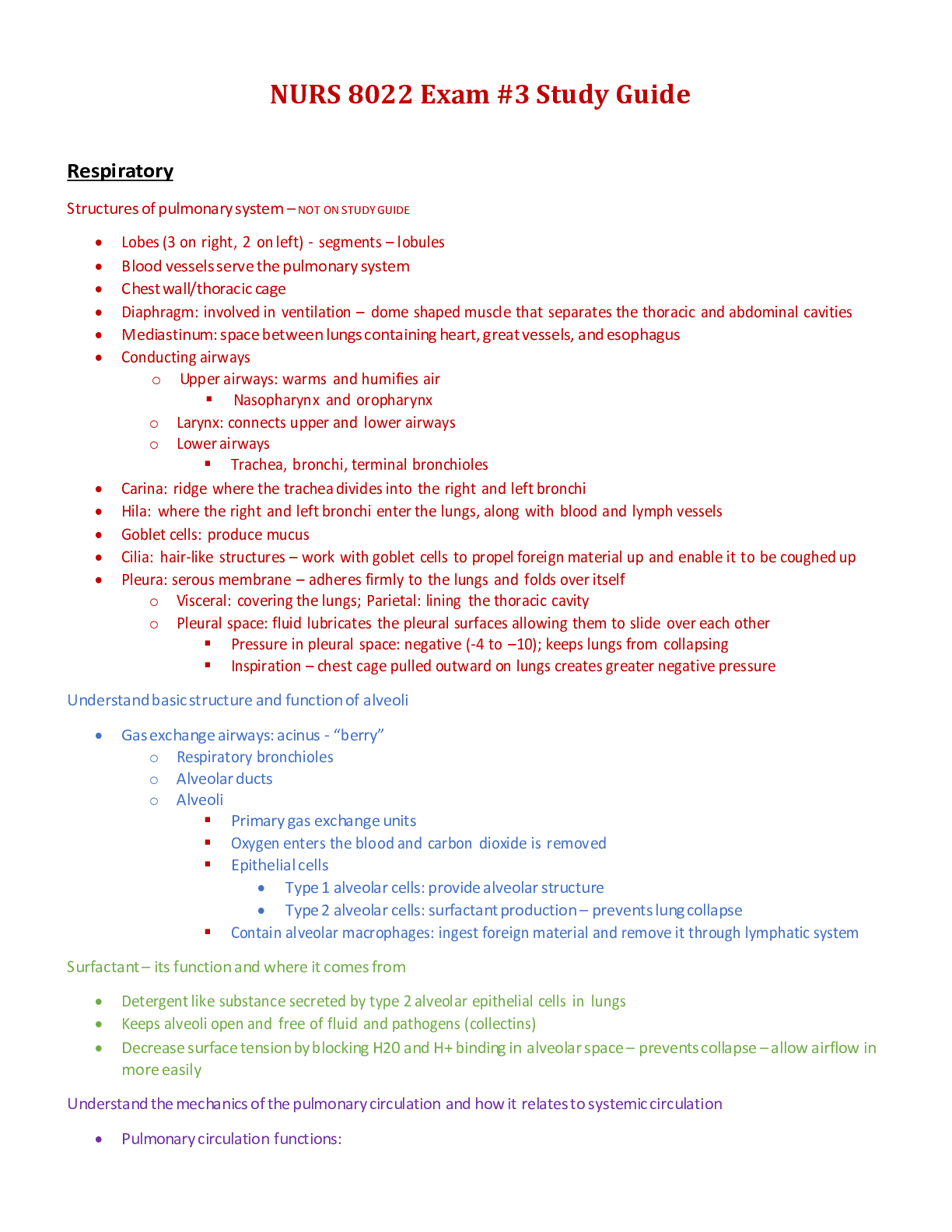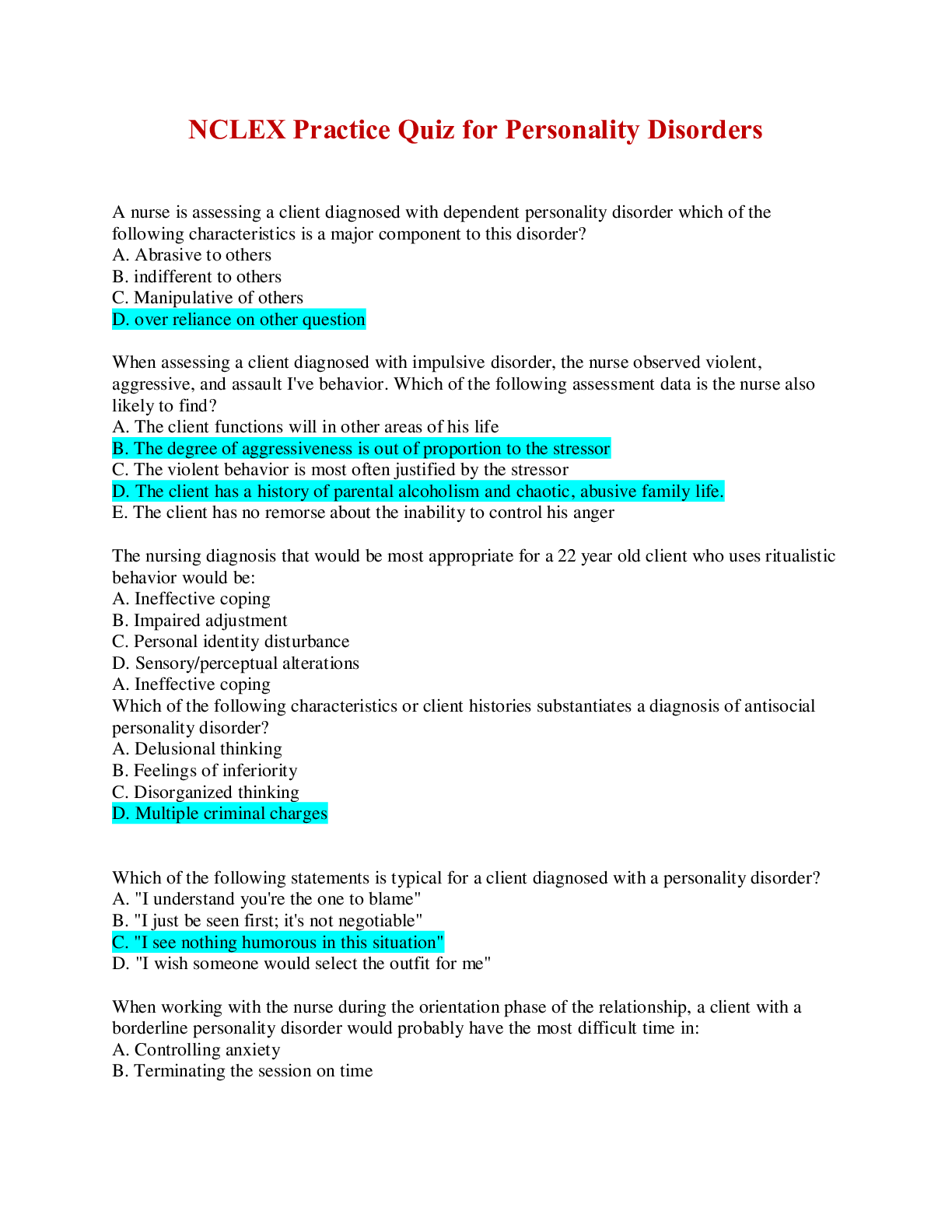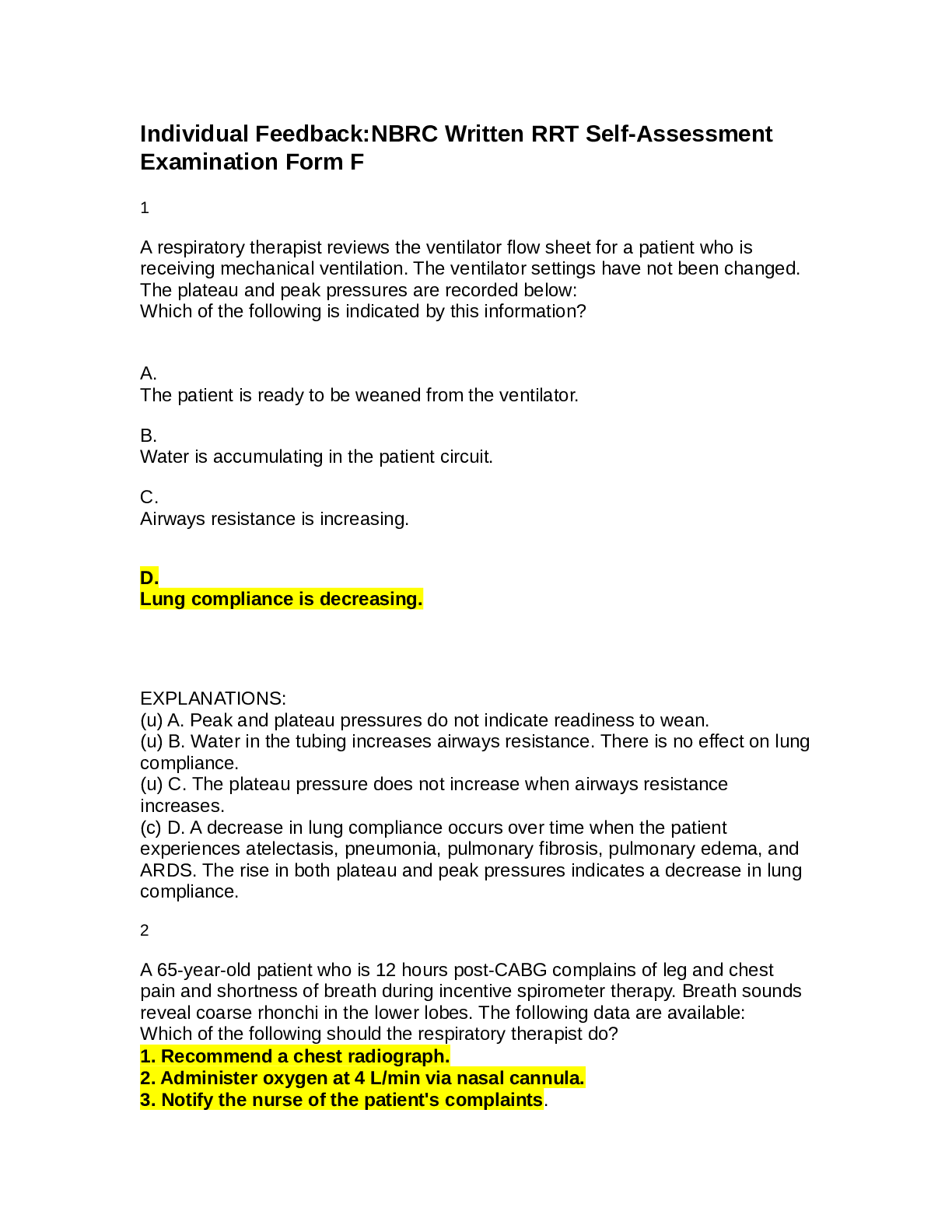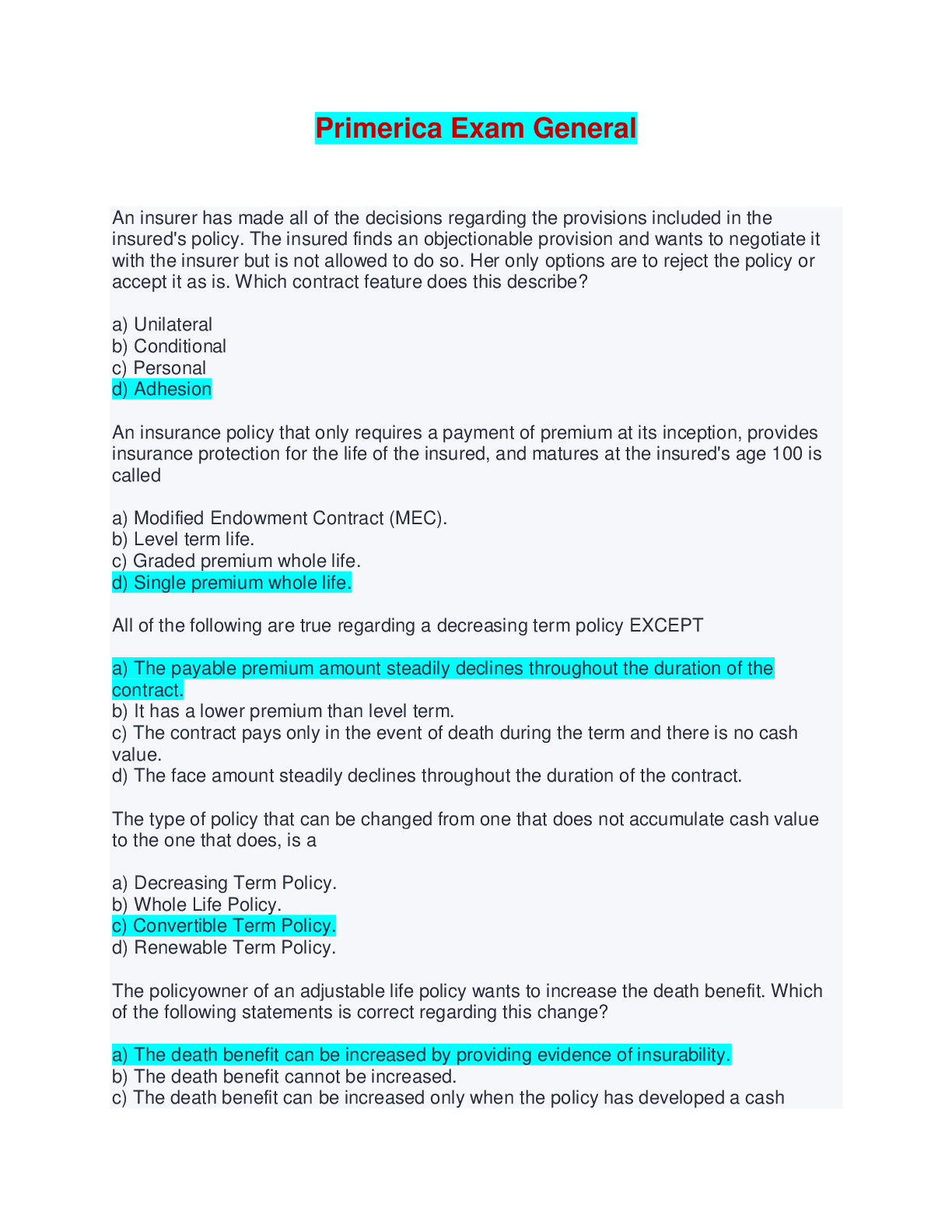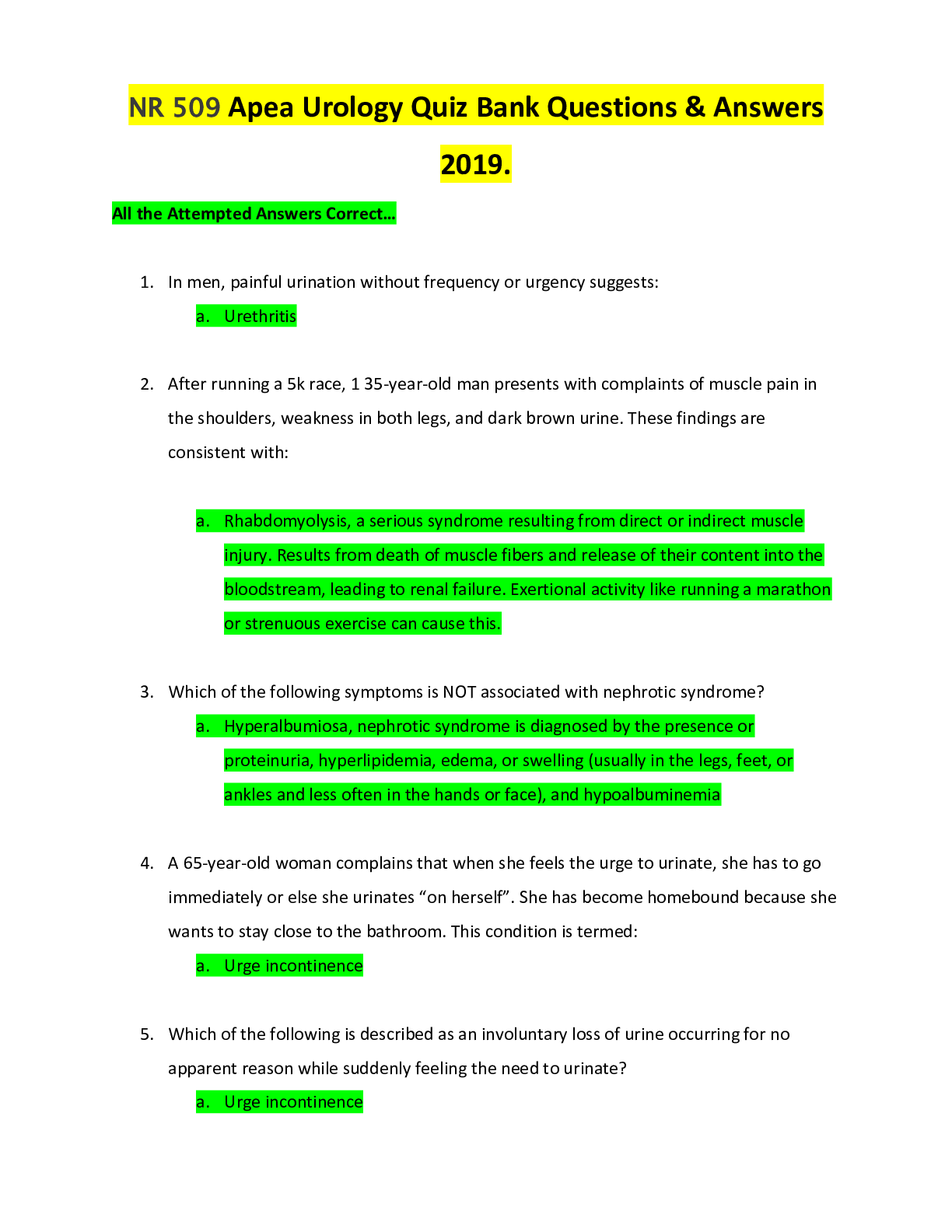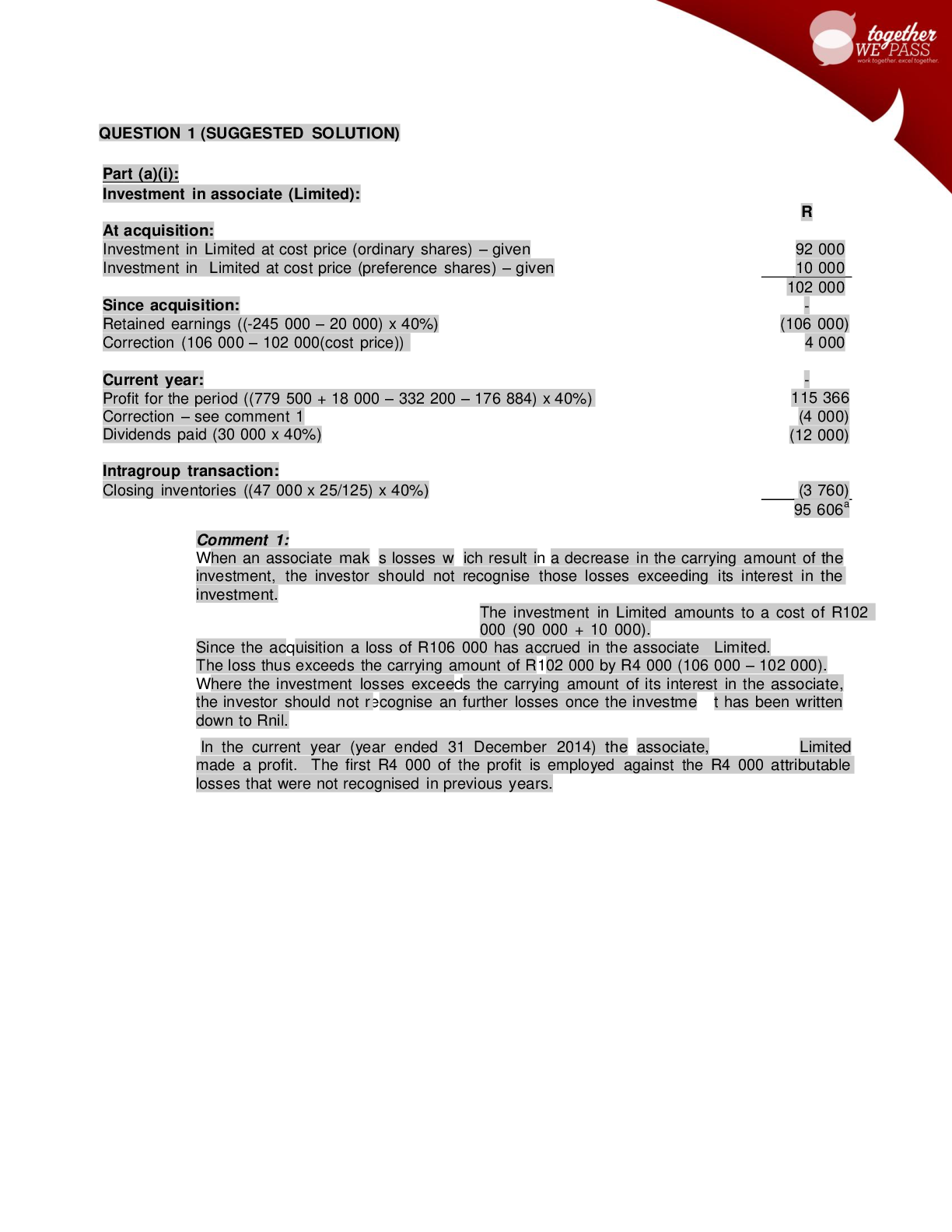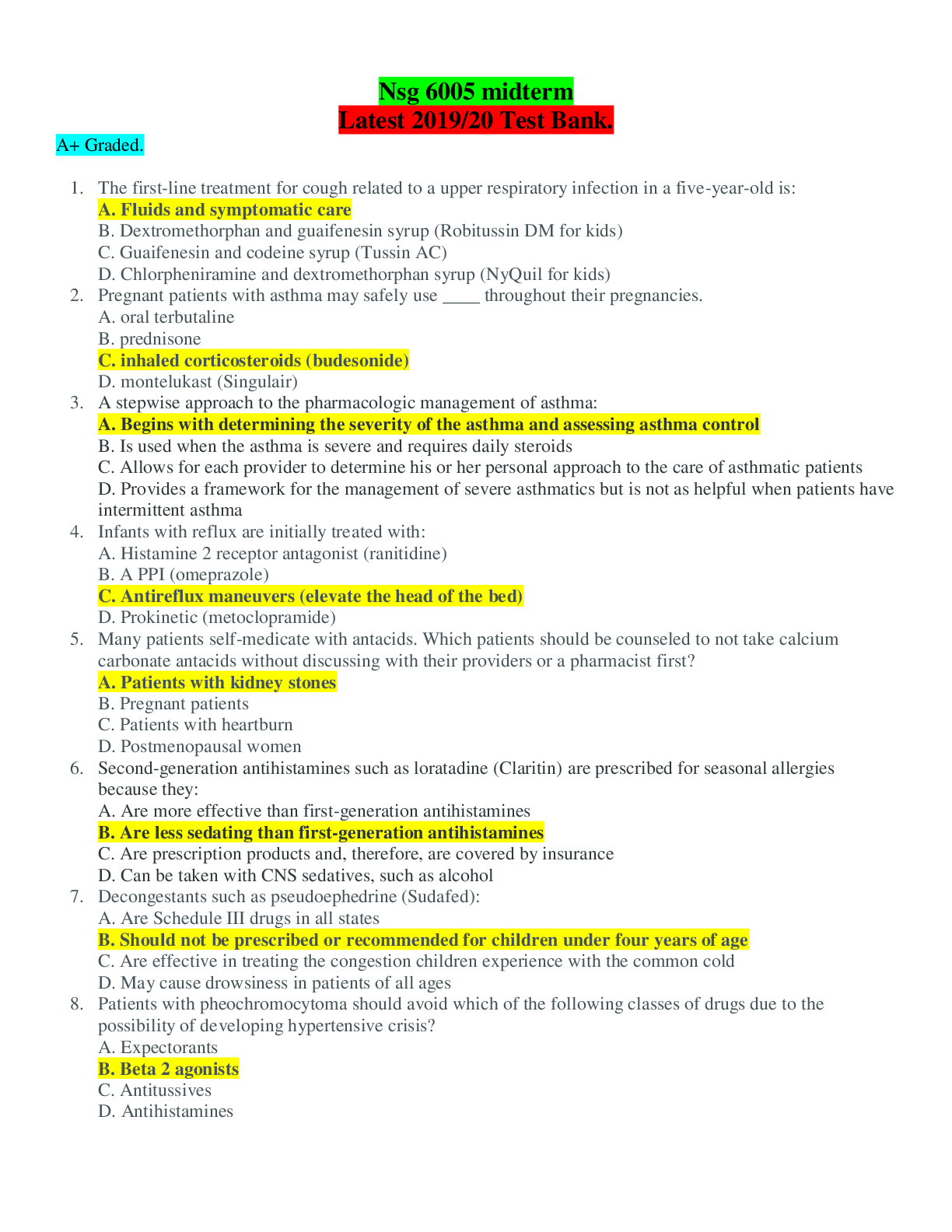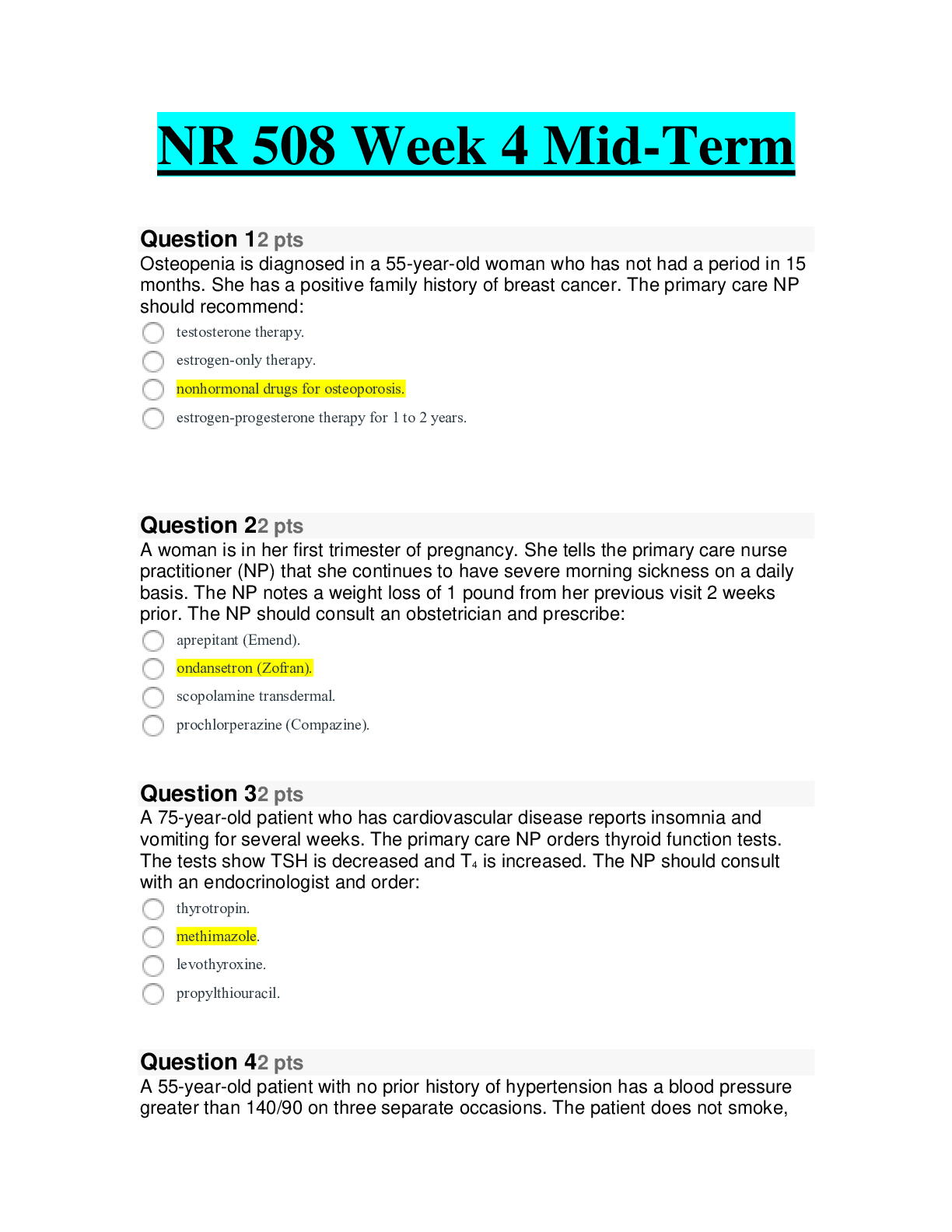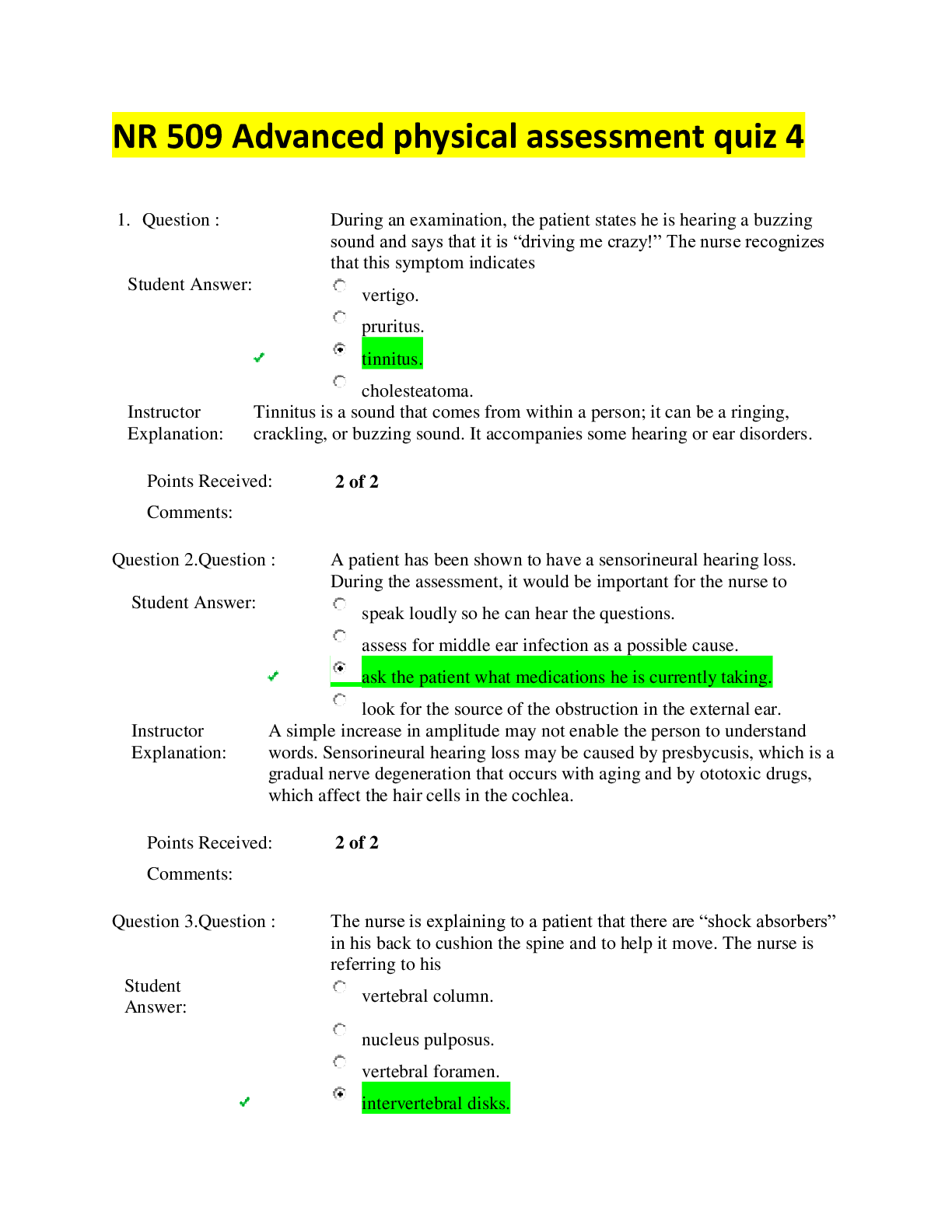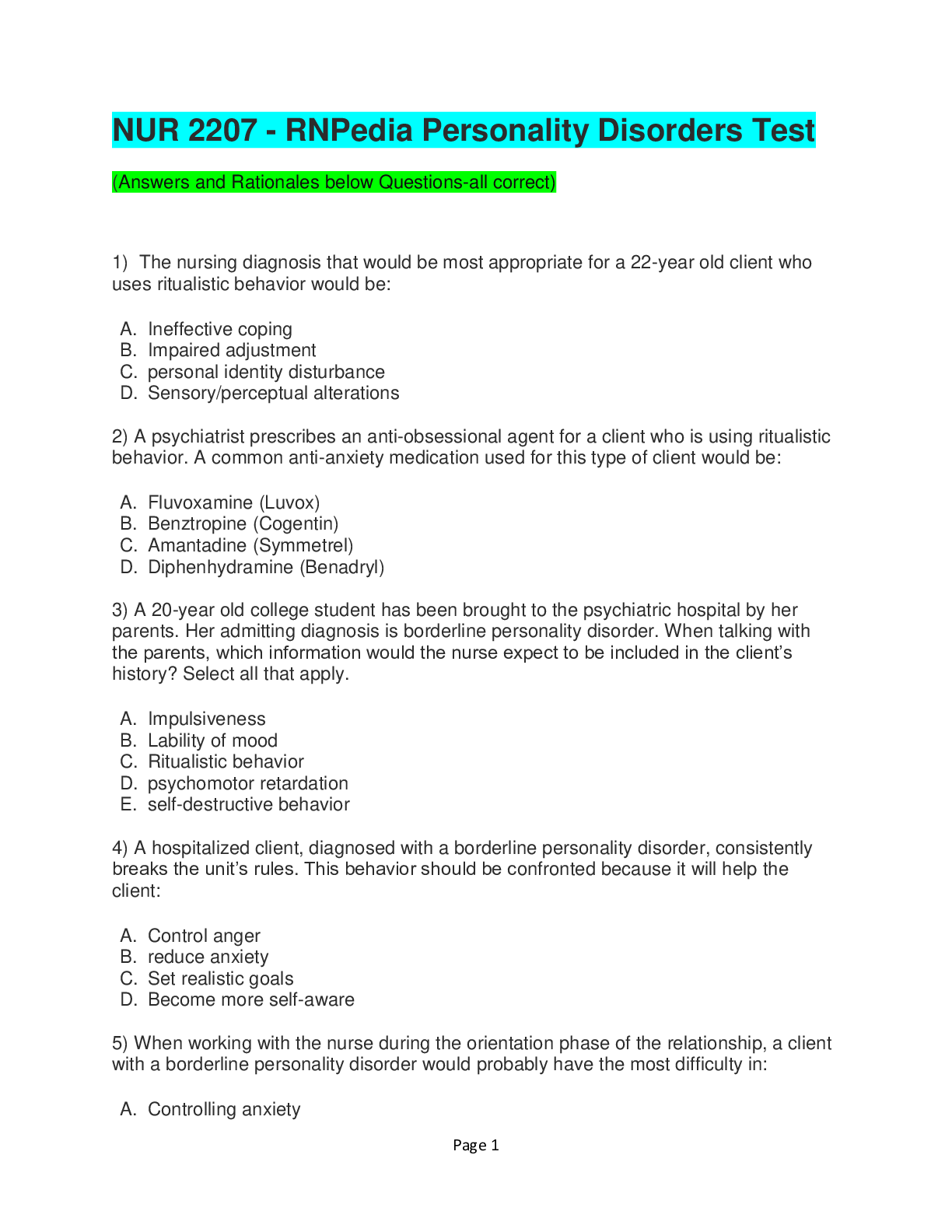EVOLVE MED SURG > EXAM > Evolve Adaptive Quiz: Med-Surg, Respiratory Test Bank - Complete Solutions with Verified Answers (All)
Evolve Adaptive Quiz: Med-Surg, Respiratory Test Bank - Complete Solutions with Verified Answers
Document Content and Description Below
Evolve Adaptive Quiz: Med-Surg, Respiratory Test Bank - Complete Solutions with Verified Answers A client who is homeless is hospitalized for alcohol withdrawal. When considering the type of persona... l protective equipment that is needed for the client's care, what condition does the nurse recall that homeless persons are at risk for? 1 Prostatitis 2 Tuberculosis 3 Osteoarthritis 4 Diverticulosis The nurse is caring for a client who is hyperventilating. The nurse recalls that the client is at risk for what? 1 Respiratory acidosis 2 Respiratory alkalosis 3 Respiratory compensation 4 Respiratory decompensation A client with a history of rheumatic fever and a heart murmur reports gaining weight in spite of nausea and anorexia. The client also reports shortness of breath several times each day and when performing minor tasks. Which additional information should the nurse obtain? 1 Retrospective 24-hour calorie count 2 Elimination pattern during the last 30 days 3 Complete gynecological and sexual history 4 Presence of a cough and pulmonary secretions The nurse is providing care during the immediate postoperative period for a client who had a radical neck dissection. What is the best method to assess for stridor? 1 Listen with a stethoscope over the trachea 2 Determine the client's ability to do neck exercises 3 Listen with a stethoscope over the base of the lungs 4 Determine the client's ability to cough and deep breathe What points should be considered when a client with a respiratory disorder undergoes a spiral-computed tomography (CT) scan to diagnose a pulmonary embolism? Select all that apply. 1 The test involves the administration of a contrast medium. 2 Clients should have their hydration levels assessed. 3 Clients are instructed to lie still on a hard table. 4 Clients are served shellfish before the test. 5 A client's serum creatinine level is evaluated after the test. The nurse is watching the technician obtain a 12-lead ECG. In which area should the nurse make sure the technician places the V1 lead? 1 Halfway between V2 and V4 2 Fourth intercostal space, left sternal border 3 Fourth intercostal space, right sternal border 4 Fifth intercostal space, left midclavicular line A client has a hysterectomy, salpingo-oophorectomy, tumor removal, and multiple abdominal biopsies for ovarian cancer. For which clinical manifestations indicating that the client may be experiencing a pulmonary embolus should the nurse assess the client? Select all that apply. 1 Flushed face 2 Increased temperature 3 Severe abdominal pain 4 Decreased oxygen saturation level 5 Sudden onset of shortness of breath A nurse is caring for a toddler in acute respiratory distress precipitated by laryngotracheobronchitis. The child has a temperature of 103° F (39.4° C). What is the priority nursing intervention? 1 Delivering humidified oxygen 2 Initiating measures to reduce fever 3 Monitoring respiratory status continuously 4 Providing support to diminish apprehension A nurse is caring for several clients in the intensive care unit. Which is the greatest risk factor for a client to develop acute respiratory distress syndrome (ARDS)? 1 Aspirating gastric contents 2 Getting an opioid overdose 3 Experiencing an anaphylactic reaction 4 Receiving multiple blood transfusions A chest tube with an attached closed-drainage system is inserted into a client who was stabbed in the chest. Which is an important nursing intervention when caring for this client? 1 Observe for fluid fluctuations in the water-seal chamber. 2 Obtain a prescription for morphine to minimize agitation. 3 Apply a thoracic binder to prevent excessive tension on the tube. 4 Clamp the tubing securely to prevent a rapid decline in pressure. Upon assessment the nurse discovers a client with heart failure has crackles in lower lung fields and dyspnea. Upon notifying the primary healthcare provider, the provider prescribes intravenous (IV) normal saline at 200 mL/hr and furosemide 120 mg orally stat. Which action should the nurse take next? 1 Place the normal saline on an infusion pump to control the amount, and give the furosemide. 2 Ask the healthcare provider why so much intravenous fluid is to be given to an older adult client, and give the furosemide as prescribed. 3 Decline to give the intravenous fluid, saying it could cause circulatory overload, and give the furosemide as prescribed. 4 Question the choice of solution, the amount to be given, and the dose of furosemide that has been prescribed. The nurse is caring for a client who has undergone a total hip replacement. The nurse recognizes which clinical manifestations that indicate a pulmonary embolism? Select all that apply. 1 Sudden chest pain 2 Flushing of the face 3 Elevation of temperature 4 Abrupt onset of shortness of breath 5 Pain rating increase from 2 to 8 in the hip A client with chest trauma is admitted in the emergency department. Which intervention takes priority? 1 Ensure patent airway. 2 Monitor the cardiac rhythm. 3 Release dressing in tension pneumothorax. 4 Anticipate intubation for respiratory distress. While walking in a hallway, a client with a chest tube becomes confused and pulls the chest tube out. What is the nurse's immediate action? 1 Place the client in the supine position 2 Spread a clamp in the insertion site to hold the site open 3 Obtain a sterile Vaseline gauze to cover the opening 4 Cover the opening with the cleanest material available A client with acute respiratory distress syndrome is intubated and placed on a ventilator. What should the nurse do when caring for this client and the mechanical ventilator? 1 Deflate the cuff on the endotracheal tube for a few minutes every one to two hours. 2 Assess the need for suctioning when the high-pressure alarm of the ventilator is activated. 3 Adjust the temperature of fluid in the humidification chamber depending on the volume of gas delivered. 4 Regulate the positive end-expiratory pressure (PEEP) according to the rate and depth of the client's respirations. A nurse is caring for a client with a chest tube. How will complete lung expansion be determined before removal of the chest tube? 1 Return of usual tidal volume 2 Decreased adventitious sounds 3 Absence of additional drainage 4 Comparison of chest radiographs A client with a pulmonary embolus is intubated and placed on mechanical ventilation. When suctioning the endotracheal tube, what should the nurse do? 1 Hyperoxygenate with 100% oxygen before and after suctioning 2 Suction two or three times in quick succession to remove secretions 3 Use the technique of short, pushing movements when applying suction 4 Apply suction for no more than 10 seconds while inserting the catheter A client with a 10-year history of emphysema is admitted in acute respiratory distress. During assessment, what does the nurse expect to identify? 1 Chest pain on inspiration 2 Prolonged expiration with use of accessory muscles 3 Signs and symptoms of respiratory alkalosis 4 Decreased respiratory rate The nurse is caring for a client with a pneumothorax and chest tube. To evaluate the effectiveness of a chest tube, the nurse assesses for which finding? 1 Productive coughing 2 Return of breath sounds 3 Increased pleural drainage in the chamber 4 Constant bubbling in the water-seal chamber After surgery, a client is extubated in the postanesthesia care unit. Which clinical manifestations should the nurse expect if the client is experiencing acute respiratory distress? Select all that apply. 1 Confusion 2 Hypocapnia 3 Tachycardia 4 Constricted pupils 5 Slow respiratory rate A client is receiving warfarin for a pulmonary embolism. Which drug is often contraindicated when taking warfarin? 1 Atenolol 2 Ferrous sulfate 3 Chlorpromazine 4 Acetylsalicylic acid A client who has a history of emphysema is transported back to the nursing unit after a radical neck dissection for cancer of the tongue. The client is receiving oxygen and an intravenous infusion. Within the first hour, the client has 50 mL of sanguineous drainage in the portable wound drainage system. Which initial action should the nurse take? 1 Inspect the dressing 2 Increase the oxygen flow rate 3 Notify the healthcare provider 4 Place the client in the supine position [Show More]
Last updated: 5 months ago
Preview 1 out of 109 pages

Buy this document to get the full access instantly
Instant Download Access after purchase
Add to cartInstant download
We Accept:

Reviews( 0 )
$20.00
Document information
Connected school, study & course
About the document
Uploaded On
Jan 25, 2024
Number of pages
109
Written in
Additional information
This document has been written for:
Uploaded
Jan 25, 2024
Downloads
0
Views
8



